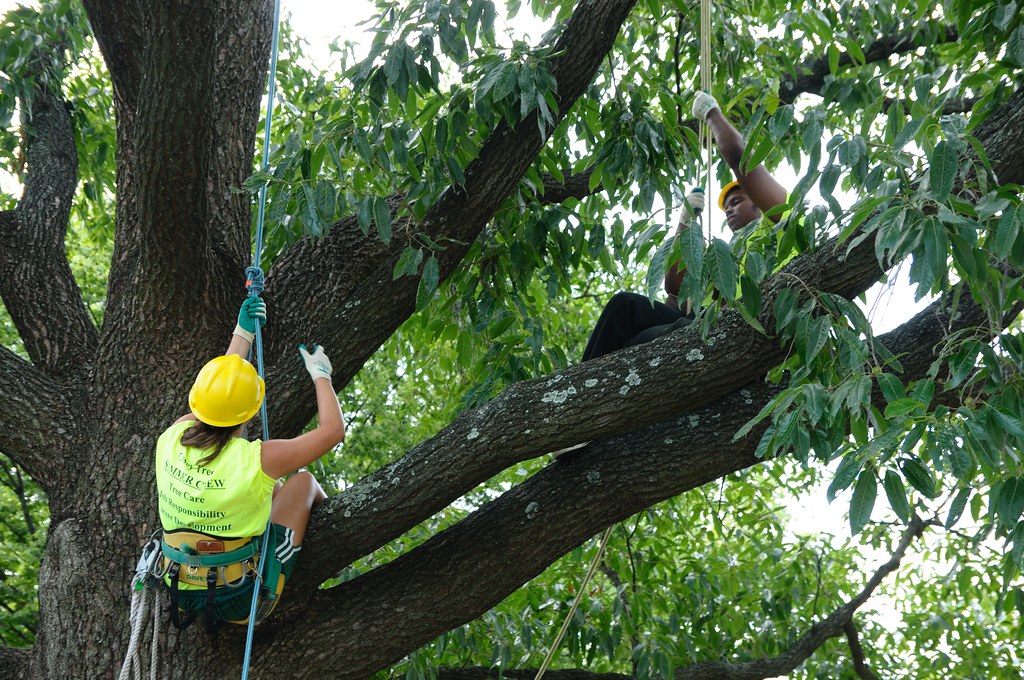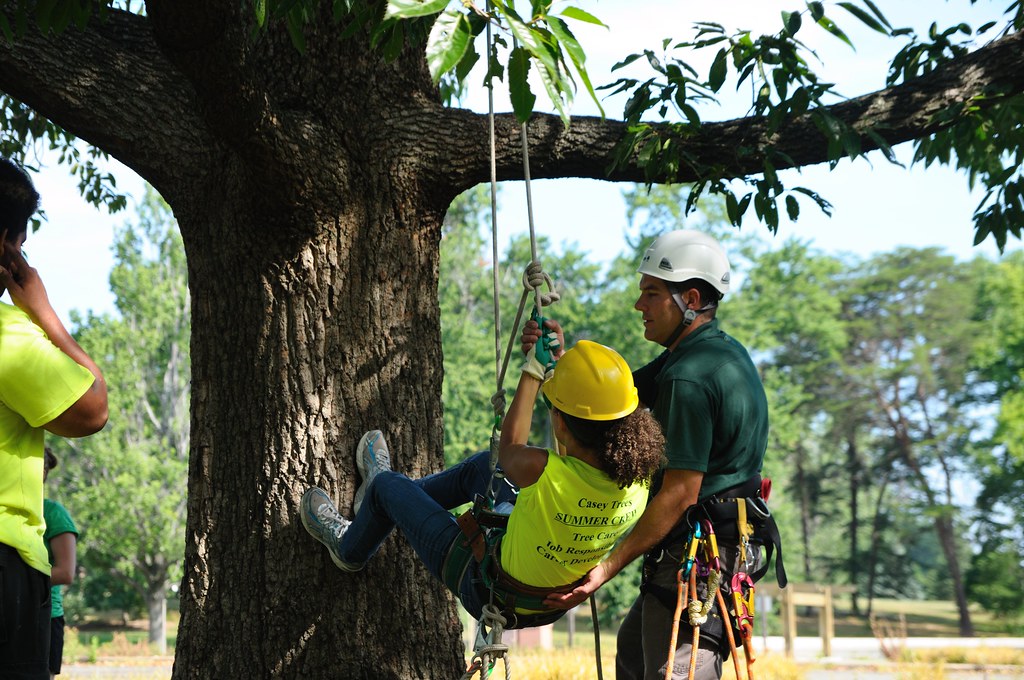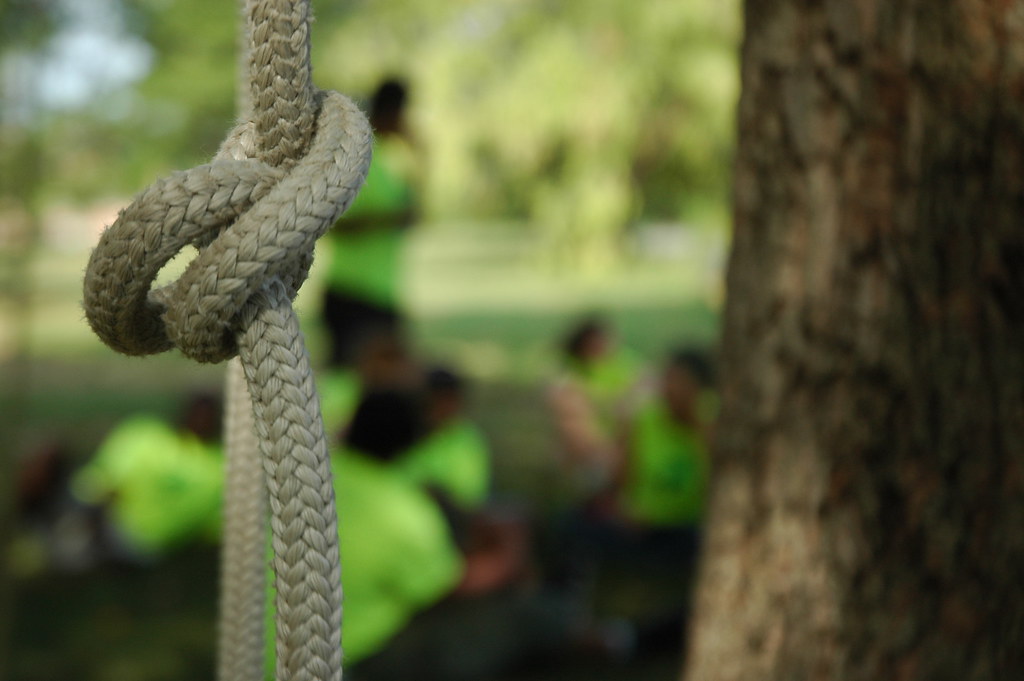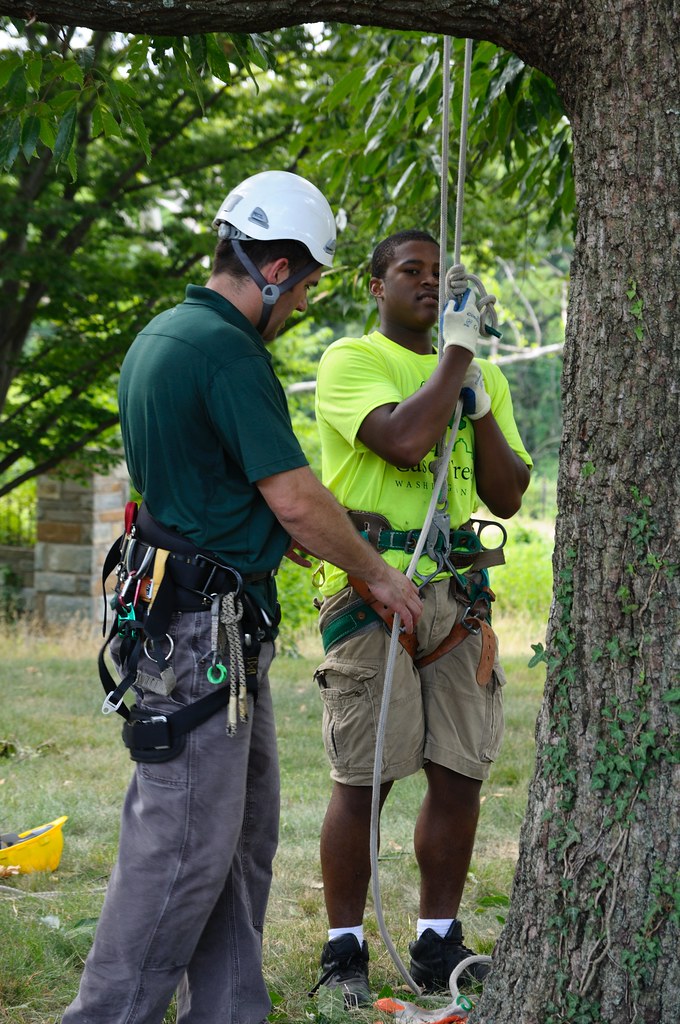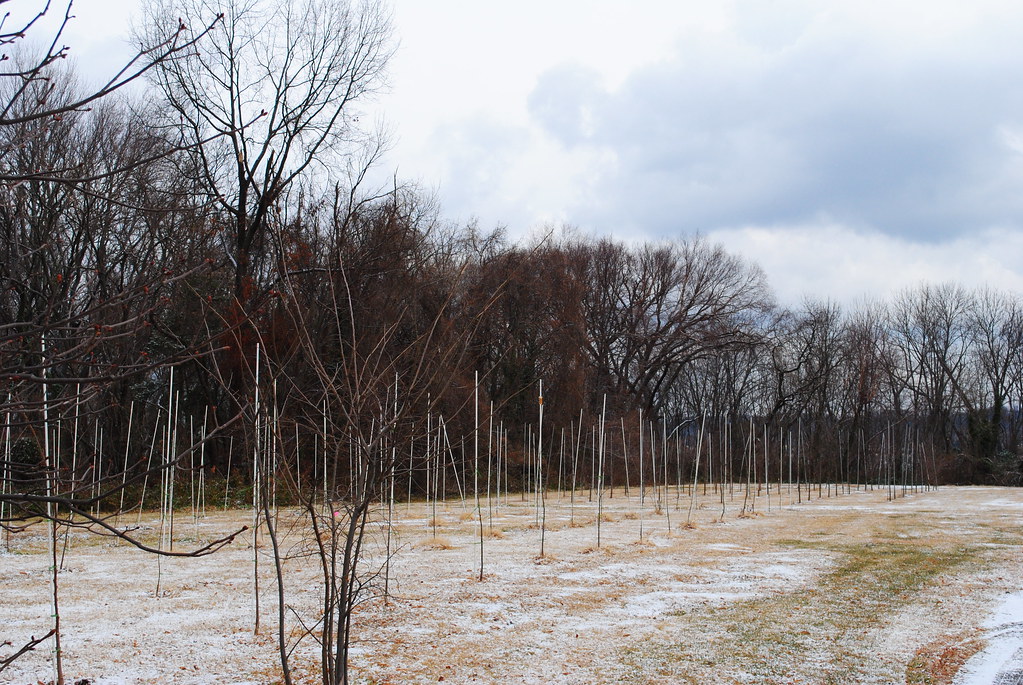Contributing writer - Neil Irvin, Water By-Cycle Crew Chief
We are now in the sixth week of the Summer Crew's Water By-Cycle program. Being a bike crew chief is both strenuous and rewarding. I love riding a bicycle but pulling a trailer with 250 feet of hose and various tree care equipment along the streets of D.C. in the summer can be a bit taxing. However, by mapping out our routes in advance we ensure we reach the greatest number of trees possible in the most efficient manner.
My crew consists of high school students who have an excellent work ethic, a love for trees and genuine desire to beautify the nation's capital. While they are caring for D.C.'s trees, they are also developing valuable professional development skills and becoming excellent communicators. I lead by example and explain things thoroughly so they can take ownership of their work.
Being a part of the bike watering crew has given me a chance to see different parts of the District, learn proper tree care and work with a great team of people. Most importantly my work is part of a greater mission - protecting D.C.'s trees. When the sun is shining and the breeze is flowing, I am reminded of how lucky I am to help lead the Casey Trees Water By-Cycle team. Our bike crew is looking forward to far surpassing our watering goals!
Sunday, July 31, 2011
Friday, July 29, 2011
Friday Photo Feature - July 29, 2011
 |
| Our recently installed irrigation system at our office. We keep trees in our garden cool using a custom irrigation system. Make sure to water your trees in this hot summer weather! |
Revolution Cycles Keeps Water By-Cycle Program Rolling
Casey Trees’ success in re-treeing D.C. is largely due to volunteer support. Each year, thousands of youth and adults donate their time and talents to plant and care for trees across the District. We are also fortunate to have individuals, businesses and foundations who support our programs and initiatives with generous financial and in-kind gifts. These gifts are especially meaningful when they come at a time of great need. Clarendon-based Revolution Cycles is one such partner who recently came to our aid.
When a street bike from our Water By-Cycle (WBC) fleet was stolen, Revolution Cycles stepped forward and donated a new Trek 700 7-speed street bike for our use. The donation of the bike meant our Summer Crew could continue caring for trees in parts of the city difficult to navigate by truck. Because of Revolution Cycles, our WBC team has "touched" more than 1,875 trees since June 22. By the end of the session, we expect the WBC fleet to have watered, weeded and mulched more than 2,600 trees. We thank Revolution Cycles for its donation, valuing our mission and helping to establish a green legacy in the District.
Do you share Revolution Cycles’ philanthropic spirit? Consider sponsoring a fall Community Tree Planting event, making a financial or in-kind (product or service) donation or volunteering at an upcoming event.
When a street bike from our Water By-Cycle (WBC) fleet was stolen, Revolution Cycles stepped forward and donated a new Trek 700 7-speed street bike for our use. The donation of the bike meant our Summer Crew could continue caring for trees in parts of the city difficult to navigate by truck. Because of Revolution Cycles, our WBC team has "touched" more than 1,875 trees since June 22. By the end of the session, we expect the WBC fleet to have watered, weeded and mulched more than 2,600 trees. We thank Revolution Cycles for its donation, valuing our mission and helping to establish a green legacy in the District.
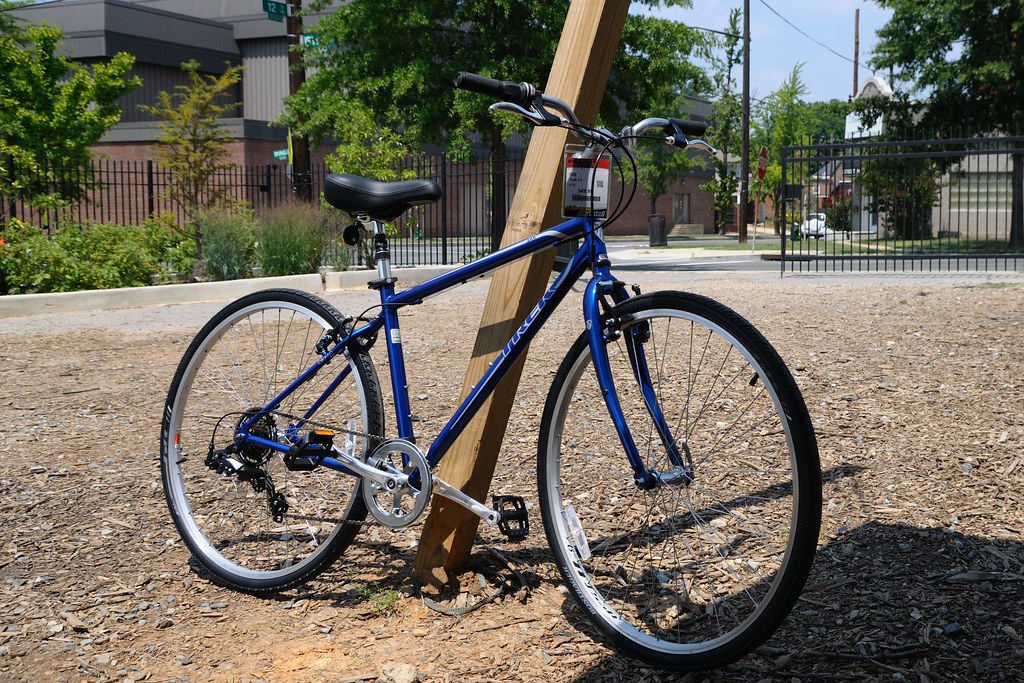 |
| Our new Trek 700. Thanks! |
Do you share Revolution Cycles’ philanthropic spirit? Consider sponsoring a fall Community Tree Planting event, making a financial or in-kind (product or service) donation or volunteering at an upcoming event.
Thursday, July 28, 2011
Summer Tree Care: Signs of Pests and Methods to Stop Them
Have you recently noticed strange markings, discolorations, or other abnormalities on your beloved trees? You may be seeing signs of a problem - a pest problem. Before trying to identify the specific pests or taking action, first take note of symptoms of your tree's affliction.
If your trees have chewed or skeletonized leaves, then sawflies, slugs or Japanese beetles may be at work. Discolored leaves or blossoms can be a sign of thrips, aphids, spider mites or lace bugs.
One simple solution for some harmful insects - including the aforementioned sawflies and aphids, among others - is horticultural oil, which has been used for much of time to protect trees and plants. While many petroleum-based oils are commercially available, there are also a number of natural, plant-based options, like cottonseed oil. Horticultural oils are safe for human contact and usually have little or no effect on surrounding wildlife or non-invasive insects. However, their use does carry a number of disadvantages.
A horticultural oil's success rate is relatively time sensitive, as they often affect their intended targets through coating a sticky - rather than toxic - film on the tree. Try to avoid spraying oil when temperatures are excessively high - the tree may already be under stress from dry conditions. Most notably, not all pests can be controlled with this method. Remember: focus on identifying the problem first, as many pest problems will need more specialized care from an arborist.
Look out for future classes on insect identification (such as our CSI for Bugs course offered last month) on our calendar of events online.
If your trees have chewed or skeletonized leaves, then sawflies, slugs or Japanese beetles may be at work. Discolored leaves or blossoms can be a sign of thrips, aphids, spider mites or lace bugs.
One simple solution for some harmful insects - including the aforementioned sawflies and aphids, among others - is horticultural oil, which has been used for much of time to protect trees and plants. While many petroleum-based oils are commercially available, there are also a number of natural, plant-based options, like cottonseed oil. Horticultural oils are safe for human contact and usually have little or no effect on surrounding wildlife or non-invasive insects. However, their use does carry a number of disadvantages.
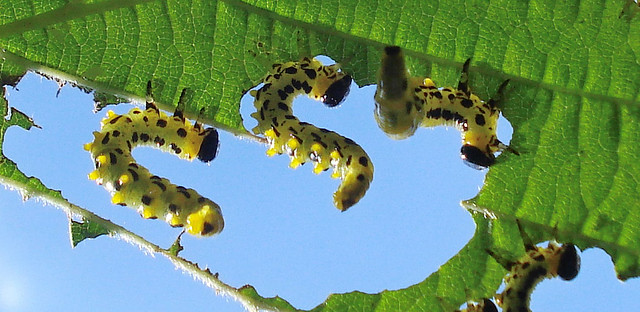 |
| Sawfly larvae devour a leaf. Photo credit: Mick E. Talbot |
A horticultural oil's success rate is relatively time sensitive, as they often affect their intended targets through coating a sticky - rather than toxic - film on the tree. Try to avoid spraying oil when temperatures are excessively high - the tree may already be under stress from dry conditions. Most notably, not all pests can be controlled with this method. Remember: focus on identifying the problem first, as many pest problems will need more specialized care from an arborist.
Look out for future classes on insect identification (such as our CSI for Bugs course offered last month) on our calendar of events online.
Tuesday, July 26, 2011
Tree Walk Recap: Tudor Place
Nine participants braved the brutal heat on Saturday morning to attend our tree walk at Tudor Place in Georgetown. Suzanne Bouchard, Director of Gardens and Grounds, led the tour. The historic site's large tree canopy not only made for an interesting tour, it also provided much-appreciated shade. The group, which included four Citizen Foresters, learned about the history of the grounds and several unique trees including a 200-year old tulip tree (Liriodendron tulipifera) that was voted D.C.’s Millennium Tree.
Can't wait for our next docent-led tour? Take advantage of our free downloadable tree walks. Sites maps are currently available for the Franciscan Monastery of the Holy Land and the NGA Sculpture Garden. A Tudor Place tree walk map will be added in the coming weeks.
Also be sure to visit our Calendar of Events webpage to learn about upcoming continuing education classes such as Stand Up for Trees and rewarding volunteer opportunities. Remember: registration is required and space is limited for all classes and volunteer events.
 |
| Bouchard talks to the group in front of the mansion at Tudor Place |
 |
| The enormous tulip tree, planted in 1805 |
Also be sure to visit our Calendar of Events webpage to learn about upcoming continuing education classes such as Stand Up for Trees and rewarding volunteer opportunities. Remember: registration is required and space is limited for all classes and volunteer events.
Labels:
Citizen Forester,
Classes,
Tree Walk,
Volunteer
Friday, July 22, 2011
Friday Photo Feature - July 22, 2011
Our High School Summer Crew visited the Franciscan Monastery as a part of their professional development learning day and our staff tagged along to take some photos at this beautiful place in Brookland. If you would like to visit the monastery yourself, make sure to bring along our guided tree walk.
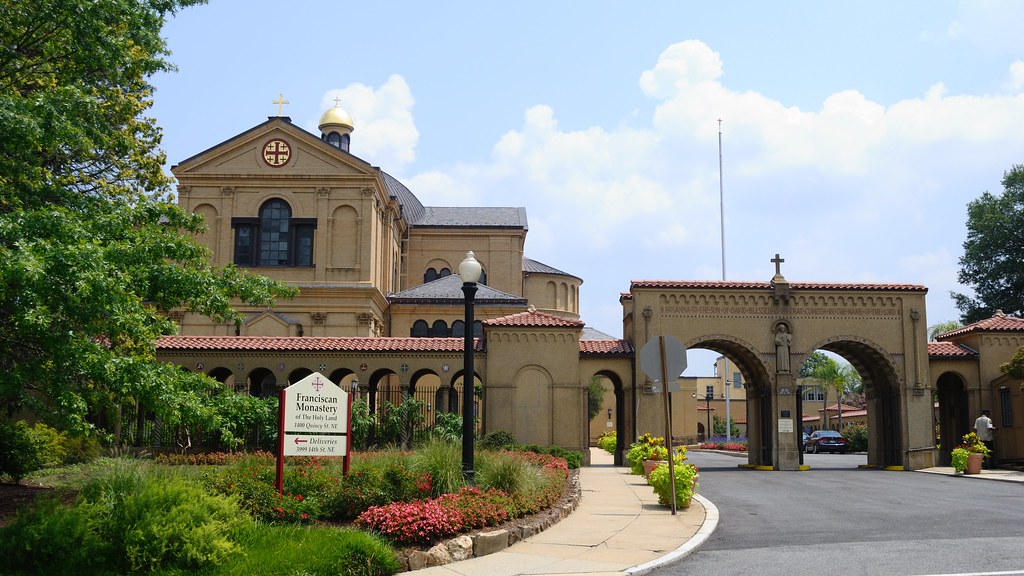 |
| The front entrance of the Franciscan Monastery. |
 |
| A Japanese maple. |
 |
| Sunlit leaves. |
 |
| Holly leaves in a shaded corner of the monastery grounds. View more on Flickr or submit your own photos of trees. |
Photos: Planning and Design Day
The High School Summer Crew completed their third professional development day Wednesday at the Casey Trees headquarters. Development days are awarded to the crew throughout the summer as long as they reach their tree care goals. The students surpassed their most recent tree touch goal, caring for a total of 3,114 trees by the end of week four. So on Wednesday, Maisie Hughes, our Planning and Design director, led the crew in several engaging activities, both on site and at the nearby Franciscan Monastery of the Holy Land.
After morning icebreakers, the summer crew learned about tree space, landscape architects and arborists. The students then split up into groups to debate various proposals for a tree space design during a mock public meeting. They wrapped up the morning with a game of planning and design jeopardy.
The afternoon segment kicked off with a power point about tree planting goals and our 3030 Rain Garden. Maisie explained to the crew the process of selecting the right trees for the garden.
The crew then set off into the hot afternoon for the Franciscan Monastery of the Holy Land. They broke off into teams to explore the beautiful gardens and analyze the landscape and treescape. Before leaving the site, the crew convened to discuss their findings. The day ended with a community planning activity.
See all of the photos from this event on Flickr.
After morning icebreakers, the summer crew learned about tree space, landscape architects and arborists. The students then split up into groups to debate various proposals for a tree space design during a mock public meeting. They wrapped up the morning with a game of planning and design jeopardy.
 |
| A group takes notes during the debate |
 |
| Crew members deliberate during Jeopardy |
The afternoon segment kicked off with a power point about tree planting goals and our 3030 Rain Garden. Maisie explained to the crew the process of selecting the right trees for the garden.
 |
| Maisie shows the crew a map of the District's tree canopy |
The crew then set off into the hot afternoon for the Franciscan Monastery of the Holy Land. They broke off into teams to explore the beautiful gardens and analyze the landscape and treescape. Before leaving the site, the crew convened to discuss their findings. The day ended with a community planning activity.
 |
| The Franciscan Monastery of the Holy Land. See our self-guided tree map of this location! |
 |
| A group examines trees surrounding the grotto |
 |
| Crew members compare and discuss notes on the landscape |
See all of the photos from this event on Flickr.
Identification and Selection: Trees 201 Class Recap
This past Saturday, a large group - most of whom were Citizen Foresters - participated in Trees 201: Identification and Selection at our Brookland headquarters. While the class was geared towards Citizen Foresters, Project Organizers and those interested in learning the basics of Right Tree, Right Space when designing a tree planting, all were welcome. There were three components of the day's lesson: tree ID, tree selection, and a field walk, which mixed classroom instruction with hands-on fieldwork, preparing those in attendance for plantings of their own.
In preparation for the class, attendees were asked to develop a planting proposal for ten trees by the Brookland rail tracks, all while sticking to three criteria: consider the neighbor's historic population of trees, incorporate trees already present at the site and plant at least 60% shade with no more than 40% small or ornamental trees. Overall, the proposals brought a variety of planting plans to the table and proved to be a valuable tool for participants to learn from each others' perspectives on tree planting.
Following the classroom portion of the day, Urban Forestry Instructor Shawn Walker and Urban Forestry Manager Sara Turner led a tree walk around our Brookland neighborhood. This allowed the future tree planting designers to see some real examples of the proper and improper placement of trees in an urban environment.
If you missed Trees 201, check out our calendar for the latest listing of upcoming classes and events. For those interested in becoming a Citizen Forester, make sure to sign up for its qualifying class Stand Up For Trees on Saturday, August 27. By September we will be announcing our schedule for even more qualifying classes so that you can earn your Citizen Forester badge by the time we begin our fall Community Tree Planting season.
In preparation for the class, attendees were asked to develop a planting proposal for ten trees by the Brookland rail tracks, all while sticking to three criteria: consider the neighbor's historic population of trees, incorporate trees already present at the site and plant at least 60% shade with no more than 40% small or ornamental trees. Overall, the proposals brought a variety of planting plans to the table and proved to be a valuable tool for participants to learn from each others' perspectives on tree planting.
 |
| Trees 201 participants on a tree walk around our Brookland neighborhood. |
Following the classroom portion of the day, Urban Forestry Instructor Shawn Walker and Urban Forestry Manager Sara Turner led a tree walk around our Brookland neighborhood. This allowed the future tree planting designers to see some real examples of the proper and improper placement of trees in an urban environment.
If you missed Trees 201, check out our calendar for the latest listing of upcoming classes and events. For those interested in becoming a Citizen Forester, make sure to sign up for its qualifying class Stand Up For Trees on Saturday, August 27. By September we will be announcing our schedule for even more qualifying classes so that you can earn your Citizen Forester badge by the time we begin our fall Community Tree Planting season.
Thursday, July 21, 2011
Summer Tree Spots: Rock Creek Park
Have you ever wanted to completely engulf yourself in nature but don't have the time for an excursion out into the country? No need to fret, as you can easily do this at Rock Creek Park without even setting foot outside the District.
Comprised of more than four square miles of urban forest and spanning portions of Wards 3 and 4, Rock Creek Park is the largest and one of the most notable parks in D.C. The park was first established by an Act of Congress in 1890, placing it among some of the nation's first national parks. Today, more than 100 years later, it is still a favorite outdoor site for Washingtonians.
Since it has been protected for such a long time, Rock Creek's forest holds some of the oldest and largest trees in Washington. Notable species you may find include tulip, white ash, American beech, hickory and red oak. By the edges of the creek green ash, hornbeam and river birch stand tall along with other varieties. This is certainly not a comprehensive species list but simply a taste of the park's vast holdings of trees.
In the past, Casey Trees has hosted a number of tree walks and events at Rock Creek. While there isn't a walk scheduled at the Park in the near future, you can see what walks are coming up on our Calendar and make sure to check out the new downloadable Tree Walks section of our website. Or, craft your own tree walk and explore all the arboreal offerings throughout Rock Creek Park. It is open daily during daylight hours, so take advantage of the late sunsets sometime this summer with an outing in the park.
Comprised of more than four square miles of urban forest and spanning portions of Wards 3 and 4, Rock Creek Park is the largest and one of the most notable parks in D.C. The park was first established by an Act of Congress in 1890, placing it among some of the nation's first national parks. Today, more than 100 years later, it is still a favorite outdoor site for Washingtonians.
 |
| A majestic cluster of trees stand tall in Rock Creek. |
Since it has been protected for such a long time, Rock Creek's forest holds some of the oldest and largest trees in Washington. Notable species you may find include tulip, white ash, American beech, hickory and red oak. By the edges of the creek green ash, hornbeam and river birch stand tall along with other varieties. This is certainly not a comprehensive species list but simply a taste of the park's vast holdings of trees.
 |
| Rock Creek's namesake creek bisects its full tree canopy in summer. |
In the past, Casey Trees has hosted a number of tree walks and events at Rock Creek. While there isn't a walk scheduled at the Park in the near future, you can see what walks are coming up on our Calendar and make sure to check out the new downloadable Tree Walks section of our website. Or, craft your own tree walk and explore all the arboreal offerings throughout Rock Creek Park. It is open daily during daylight hours, so take advantage of the late sunsets sometime this summer with an outing in the park.
Stand Up for Trees!
We know that increasing the District's Urban Tree Canopy (UTC) from 35% to 40% by 2035 will be no small feat. Casey Trees is determined to make it happen, but it will take the support of informed citizen advocates to help us get there.
On Saturday August 27, we invite you to attend our free class, Stand Up for Trees. The course will be held at our headquarters, 3030 12th Street NE, and will run from 9 a.m. until 2 p.m. Maisie Hughes, Director of Planning and Design, Sue Erhardt, Director of Education and Shawn Walker, Urban Forestry Instructor, will teach you everything you need to know to advocate for trees in your community.
Stand Up for Trees will:
On Saturday August 27, we invite you to attend our free class, Stand Up for Trees. The course will be held at our headquarters, 3030 12th Street NE, and will run from 9 a.m. until 2 p.m. Maisie Hughes, Director of Planning and Design, Sue Erhardt, Director of Education and Shawn Walker, Urban Forestry Instructor, will teach you everything you need to know to advocate for trees in your community.
Stand Up for Trees will:
- Teach you about the tools that are provided by the District's municipal services
- Provide advice from community members who have effectively increased their neighborhoods' tree canopy
- Help you create action plans to stand up for your community's trees
- Qualify you as a Citizen Forester
- Feed you - a light breakfast and lunch will be provided
Wednesday, July 20, 2011
Mid-Season Update: High School Summer Crew
Contributing writer - Priscilla Bocskor, Education Coordinator
I can’t believe we are over halfway through the High School Summer Crew 2011 session! The Summer Crew Water By-Cycle and truck crews have continued to surpass their tree touch goal and have completed 3,114 tree touches by the end of Week 4. Any time the summer crew waters, weeds or mulches a tree that equals a tree touch. The overall tree touch goal by the end of Week 8 is 5,496. I'm sure we'll be able to achieve our goals by graduation day on August 12.
The crew has worked hard, biking and driving all over D.C. to reach trees from Casey Trees plantings from the past three years to help them survive these hot, humid summer days. As rewards for all of their hard work the students have been rewarded with three Career Development Days so far. At Daingerfield Island, they had the opportunity to learn all about the nursery industry while helping plant and care for young American elm trees that may someday be planted on the National Mall. More recently at the Arboretum, the students learned what an arborist does and had the opportunity to climb trees! Today they are learning about planning, design and advocacy at Casey Trees headquarters and the Franciscan Monastery in Brookland.
I know the students will continue to work hard and provide excellent tree care to D.C.’s trees during their next four weeks.
 |
| The summer crew watering trees at Met Branch Trail. |
I can’t believe we are over halfway through the High School Summer Crew 2011 session! The Summer Crew Water By-Cycle and truck crews have continued to surpass their tree touch goal and have completed 3,114 tree touches by the end of Week 4. Any time the summer crew waters, weeds or mulches a tree that equals a tree touch. The overall tree touch goal by the end of Week 8 is 5,496. I'm sure we'll be able to achieve our goals by graduation day on August 12.
The crew has worked hard, biking and driving all over D.C. to reach trees from Casey Trees plantings from the past three years to help them survive these hot, humid summer days. As rewards for all of their hard work the students have been rewarded with three Career Development Days so far. At Daingerfield Island, they had the opportunity to learn all about the nursery industry while helping plant and care for young American elm trees that may someday be planted on the National Mall. More recently at the Arboretum, the students learned what an arborist does and had the opportunity to climb trees! Today they are learning about planning, design and advocacy at Casey Trees headquarters and the Franciscan Monastery in Brookland.
I know the students will continue to work hard and provide excellent tree care to D.C.’s trees during their next four weeks.
Thank You, Steinbruck Center Volunteers!
Thank you to all the volunteers who helped out at our latest tree care events!
On Monday, 26 volunteers from Peach Lutheran Church in Waunakee, Wisconsin connected with Casey Trees through the Steinbruck Center to care for trees at the Metropolitan Branch Trail. 25 trees were watered and weeded. The following day, 18 volunteers returned to tend to 33 more trees. The volunteers, along with several members from our high school summer crew, cared for the trees in record time on Tuesday, completing the task in one hour!
Casey Trees planted trees along the Met Branch Trail at two Community Tree Planting events this past April and December. If you are interested in organizing a group tree care event, please contact Carol Herwig at cherwig@caseytrees.org.
View photos of our Tree Care events on Flickr.
On Monday, 26 volunteers from Peach Lutheran Church in Waunakee, Wisconsin connected with Casey Trees through the Steinbruck Center to care for trees at the Metropolitan Branch Trail. 25 trees were watered and weeded. The following day, 18 volunteers returned to tend to 33 more trees. The volunteers, along with several members from our high school summer crew, cared for the trees in record time on Tuesday, completing the task in one hour!
 |
| A young volunteer from Peach Lutheran Church waters a tree at Met Branch Trail |
Casey Trees planted trees along the Met Branch Trail at two Community Tree Planting events this past April and December. If you are interested in organizing a group tree care event, please contact Carol Herwig at cherwig@caseytrees.org.
View photos of our Tree Care events on Flickr.
Tuesday, July 19, 2011
Summer Crew Update #5: Professional Development at the U.S. National Arboretum
For the past four weeks, our High School Summer Crew has been quite busy caring for trees throughout the District. This Wednesday, the crew got a break from their hard work with a professional development day of tree climbing at the United States National Arboretum. Casey Trees would like to thank Colien Hefferan, Director of the Arboretum for welcoming our Summer Crew and making this event possible.
Contributing writer - Zakara Wardlow, Summer Crew Team Member
After exceeding our crew's goals, we had the opportunity to participate in our second career development day: learning how to climb trees at the National Arboretum. When we arrived we were greeted by Master Arborist Steve Nagy from Davey Tree who gave us preparation and instruction on how to properly climb a tree using a rope and harness system. We learned the basic techniques and learned about the use of tree climbing by arboreal professionals, including pruning techniques. It was really fun to climb and proved to be very physically challenging as well. All of the crew and Casey Trees staff had the chance to climb the tree. After testing our tree climbing skills, we took a break for lunch and got ready to explore the grounds of the Arboretum.
We were introduced to the Arboretum's extensive collection of Japanese bonsai trees. Bonsai trees are carefully pruned miniature trees grown in a small pot of soil. These trees often live for long periods of time with careful attention. We were shown the oldest tree in the United States - a bonsai that was around 400 years old! I thought it was great to be able to see that in person. Tony Vlahakis and Michael Rayburn (tree experts at the Arboretum) gave us a tour of the grounds, showing us the white oak (state tree of Maryland and Illinois) and the tulip tree (state tree of Indiana, Tennessee and Kentucky). We had the chance to improve and demonstrate our ability to identify trees. Unfortunately, our trip was cut short because of stormy weather, but we were glad to have the chance to participate in another career development day.
Some photos from this event (more can be found on Flickr):
Contributing writer - Zakara Wardlow, Summer Crew Team Member
After exceeding our crew's goals, we had the opportunity to participate in our second career development day: learning how to climb trees at the National Arboretum. When we arrived we were greeted by Master Arborist Steve Nagy from Davey Tree who gave us preparation and instruction on how to properly climb a tree using a rope and harness system. We learned the basic techniques and learned about the use of tree climbing by arboreal professionals, including pruning techniques. It was really fun to climb and proved to be very physically challenging as well. All of the crew and Casey Trees staff had the chance to climb the tree. After testing our tree climbing skills, we took a break for lunch and got ready to explore the grounds of the Arboretum.
We were introduced to the Arboretum's extensive collection of Japanese bonsai trees. Bonsai trees are carefully pruned miniature trees grown in a small pot of soil. These trees often live for long periods of time with careful attention. We were shown the oldest tree in the United States - a bonsai that was around 400 years old! I thought it was great to be able to see that in person. Tony Vlahakis and Michael Rayburn (tree experts at the Arboretum) gave us a tour of the grounds, showing us the white oak (state tree of Maryland and Illinois) and the tulip tree (state tree of Indiana, Tennessee and Kentucky). We had the chance to improve and demonstrate our ability to identify trees. Unfortunately, our trip was cut short because of stormy weather, but we were glad to have the chance to participate in another career development day.
Some photos from this event (more can be found on Flickr):
Monday, July 18, 2011
Volunteers Help Our Trees Stay Hydrated at Alice Deal School
Thanks to a group of Stanford alumni for all their help watering trees at Alice Deal Middle School this past Saturday morning. An eclectic group group of ten representing recent graduates, older alumni and even some future students came out to Alice Deal, managing to water and weed 57 trees!
Casey Trees has held a number of Community Tree Planting events at Alice Deal, most recently this past May. With temperatures expected to hit triple digits later in the week, these young trees certainly got a much-needed watering.
If you would like to organize a group tree watering event, please contact Volunteer Coordinator Carol Herwig at cherwig@caseytrees.org. And remember, young trees need 25 gallons of water per week to grow healthy and strong. Take the 25 to Stay Alive Pledge and receive a free rain gauge to help you monitor your trees' water intake.
Casey Trees has held a number of Community Tree Planting events at Alice Deal, most recently this past May. With temperatures expected to hit triple digits later in the week, these young trees certainly got a much-needed watering.
 |
| Two volunteers fill a young tree's ooze tube. |
Friday, July 15, 2011
Downloadable Tree Maps are a Walk in the Park
Take a break from your regular walk route this summer with our free self-guided tree walks! New downloadable tree walks will be added to our website monthly, providing you with a fun and easy way to learn more about the District’s urban canopy.
Each downloadable tree walk features a map of the various trees at a popular location in D.C. This month, we are featuring tree maps of the National Gallery of Art Sculpture Garden and the Franciscan Monastery of the Holy Land. Touring the trees at these beautiful locations is easy. Just print up our map to use as a reference as you explore the site at your own pace.
Each map features:
Our downloadable tree walks allow you to stroll great tree spots around the District on your own time, at your own pace. But don’t forget: Casey Trees still offers tree walks in person at various locations around the District, so be sure to check our calendar for upcoming docent-led tours. Also check out our blog posts on other great summer spots in D.C.!
Each downloadable tree walk features a map of the various trees at a popular location in D.C. This month, we are featuring tree maps of the National Gallery of Art Sculpture Garden and the Franciscan Monastery of the Holy Land. Touring the trees at these beautiful locations is easy. Just print up our map to use as a reference as you explore the site at your own pace.
  |
| Our downloadable tree walks for the month of July. Click on the image for the full map. |
Each map features:
- An introduction to the site
- Locations of the site’s notable trees
- The scientific and common name of each tree
- The identifying characteristics of each featured species
- A walking rating that defines the level of difficulty, ADA accessibility, distance and estimated walking time
Our downloadable tree walks allow you to stroll great tree spots around the District on your own time, at your own pace. But don’t forget: Casey Trees still offers tree walks in person at various locations around the District, so be sure to check our calendar for upcoming docent-led tours. Also check out our blog posts on other great summer spots in D.C.!
 |
| A sculpture and notable tree at the NGA Sculpture Garden. |
Friday Photo Feature - July 15, 2011
One of the benefits of trees in an urban environment is providing a habitat for wildlife. Right outside the Casey Trees office we found a nest of mockingbirds in a street tree.
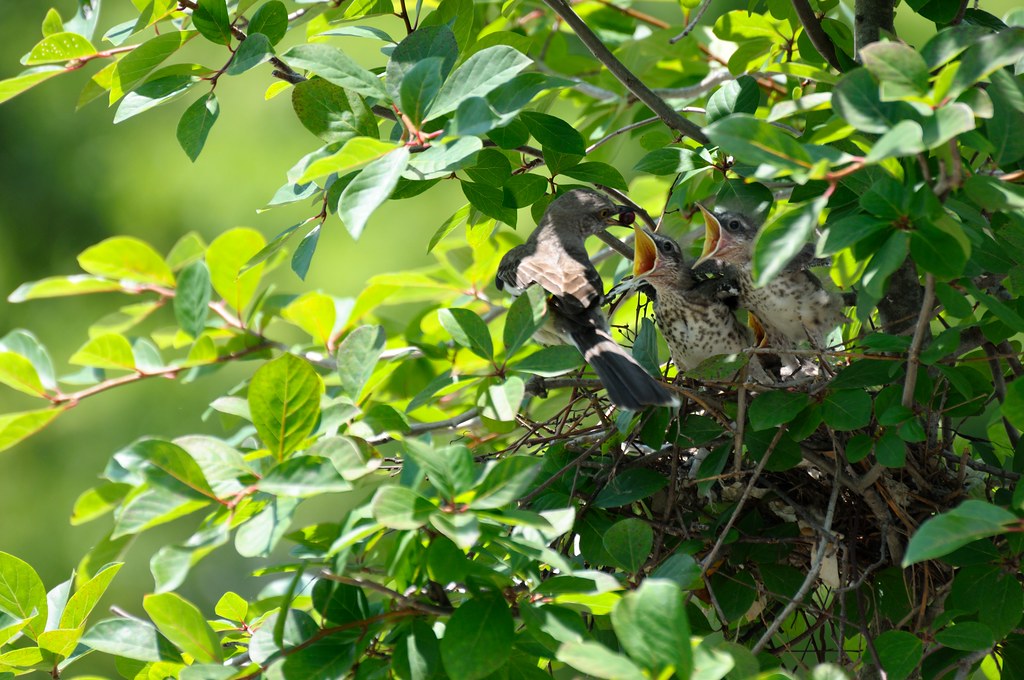 |
| A mockingbird feeding its young outside the Casey Trees tree yard. |
 |
| The nest of mockingbirds built in a street tree. |
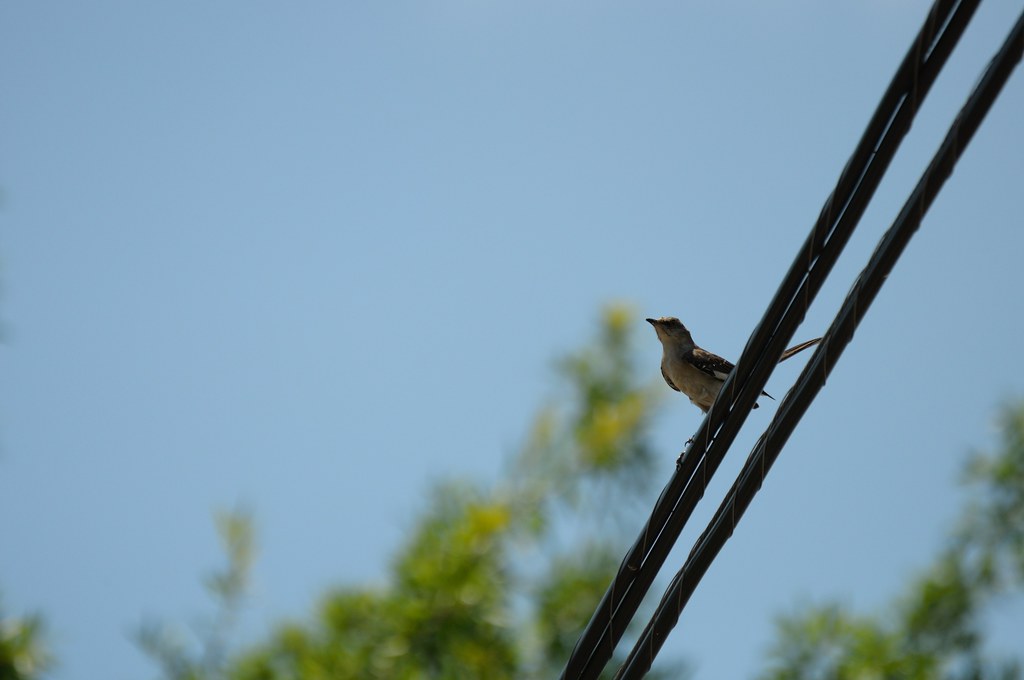 |
| The parent mockingbird perched on a power line. View more on Flickr or submit your own photos of trees. |
Thursday, July 14, 2011
Summer Tree Care: Mulching
So far in our summer tree care blog series, we have covered watering, pruning and careful gardening. Today’s topic is an issue of surprisingly growing concern for all tree care-takers: mulching.
When applied properly, mulch can greatly benefit your trees by:
Here are a few simple tips to keep in mind when mulching your tree:
When applied properly, mulch can greatly benefit your trees by:
- Controlling weeds and grass
- Maintaining moisture in the soil and keeping your tree hydrated
- Protecting the roots and trunk from mowers and other lawn maintenance tools
Here are a few simple tips to keep in mind when mulching your tree:
- Use organic mulch. While inorganic mulch is sometimes useful for soil protection, organic materials are best when mulching trees. Shredded bark, leaf compost, and composted wood chips all work well.
- Remember the 3-3-3 Rule. Create a ring of mulch around your tree, 3 inches deep in a 3-foot radius from the trunk, making sure to leave a 3-inch space right around the tree trunk.
- Avoid volcanoes. Don’t pile the mulch against the trunk of your tree. When you’re finished, the mulch should look more like a doughnut than a volcano.
Wednesday, July 13, 2011
Summer Crew Update #4: Tree Care Lessons
Contributing writer - Sarah Turner, Summer Crew Team Member
In my third week as a Summer Crew team member, I have learned a few important tree care basics. Although many people believe that trees are self-sufficient and do not require much care after being planted, young trees need extra attention the first three years they are in the ground.
The standard rule of thumb is to ensure each newly planted tree receives 25 gallons of water per week - the exact amount our slow-release watering bags hold. However, it is important to evaluate each individual tree's needs. Some trees may show signs of distress, such as browning of leaves and could use additional water to help return them to health. I have learned to pay attention and respond to these small signs.
Weeding and mulching is frequently overlooked. Weeding removes competition for nutrients and mulching prevents weeds from returning and keeps the soil moist. Both are very important to do in the summer months and only takes a few minutes to do.
Lastly, be careful with lawn care equipment like lawnmowers. One nick on a tree's trunk can sever its nutrient transportation system. The tree may not show signs immediate signs of distress but small tears and cuts can be fatal. Adding trunk guards at the base of the tree and protective mulch ring can help safeguard your trees.
In my third week as a Summer Crew team member, I have learned a few important tree care basics. Although many people believe that trees are self-sufficient and do not require much care after being planted, young trees need extra attention the first three years they are in the ground.
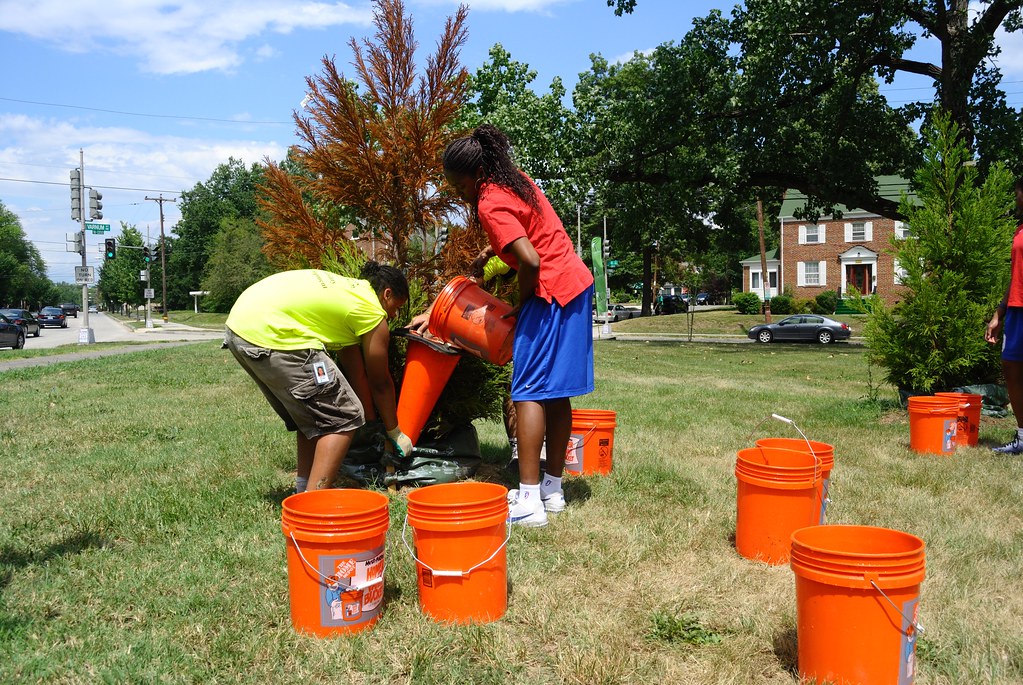 |
| Stressed trees may need extra care. |
The standard rule of thumb is to ensure each newly planted tree receives 25 gallons of water per week - the exact amount our slow-release watering bags hold. However, it is important to evaluate each individual tree's needs. Some trees may show signs of distress, such as browning of leaves and could use additional water to help return them to health. I have learned to pay attention and respond to these small signs.
Weeding and mulching is frequently overlooked. Weeding removes competition for nutrients and mulching prevents weeds from returning and keeps the soil moist. Both are very important to do in the summer months and only takes a few minutes to do.
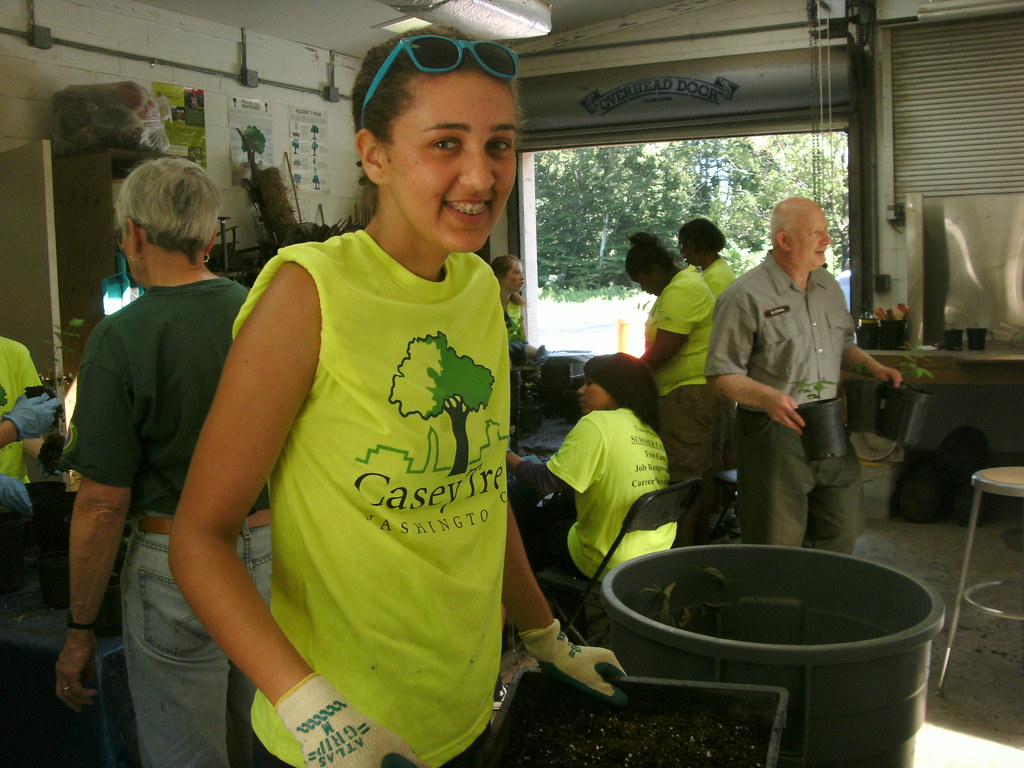 |
| Summer Crew member Sarah Turner working at Daingerfield Island. |
Lastly, be careful with lawn care equipment like lawnmowers. One nick on a tree's trunk can sever its nutrient transportation system. The tree may not show signs immediate signs of distress but small tears and cuts can be fatal. Adding trunk guards at the base of the tree and protective mulch ring can help safeguard your trees.
This Week on Tree Talk Thursday: Summer Tree Care
Summertime in the District means heat, humidity and dry spells. Our trees - particularly those that have been planted recently - need plenty of water to survive challenging summer conditions. We want to answer your questions about summer tree care so that you can get more involved with trees in your neighborhood.
 |
| Remember, your young trees need 25 gallons of water - approximately 1.5 inches of rain per week. |
Tune in to Tree Talk Thursday, tomorrow, July 14 at 12:00 PM for a live, online discussion with John Thomas, Associate Director of the Urban Forestry Administration (UFA), and Casey Trees' Urban Forestry Instructor Shawn Walker, for a guide to keeping your trees healthy and strong throughout the summer months.
To submit a question in advance, you can email treedc@caseytrees.org or tweet @CaseyTrees. Tree Talk Thursday is held regularly on the second Thursday of each month from 12:00 to 1:00 PM and can be accessed here.
Tuesday, July 12, 2011
Simon Elementary School Pruning Recap
This past Saturday, 13 volunteers came out to Simon Elementary School to help give trees some much-needed tender, love and pruning. The volunteers joined five Casey Trees staff members to tend to about 60 trees on the school's grounds and surrounding parks. Among the group were 11 Citizen Foresters and six returning volunteers from the last pruning event at Murch Elementary.
There was a wide range of tree species on site, including cherry, elm, zelkova, pin oak, red maple, crepe myrtle, and river birch. Due to the hot, dry conditions and lack of attention, many of the trees had branches that were dead or brown. But the short pruning event went a long way to improve the health of the trees. By 10:45 a.m. our staff and volunteers had taken care of the whole area!
If you're interested in volunteering for our next pruning event on August 20th at Lafayette High School, contact Shawn Walker, our Urban Forestry Instructor, at swalker@caseytrees.org. Citizen Foresters are highly encouraged to sign up - and if you've already attended at least one pruning event this summer, you can still receive a free pair of pruners! Check our calendar for all upcoming events as well.
 |
| Volunteers put their pruning skills to good use on a young tree |
If you're interested in volunteering for our next pruning event on August 20th at Lafayette High School, contact Shawn Walker, our Urban Forestry Instructor, at swalker@caseytrees.org. Citizen Foresters are highly encouraged to sign up - and if you've already attended at least one pruning event this summer, you can still receive a free pair of pruners! Check our calendar for all upcoming events as well.
Monday, July 11, 2011
Summer Crew: Tree Planting Crew Update
Contributing writer - Mike Nelson, Urban Forestry Crew Chief
Wow! Time flies when you’re blasting through thousands of trees, providing excellent annual care and much needed hydration amidst another blistering summer. We are entering week four of the Casey Trees Summer Crew program 2011. As a co-leader of six exuberant young men and women, I have the privilege of performing a necessary component of Tree Care while engaging in the maturation and career development of D.C.'s next generation of environmental ambassadors.
On a typical summer day, we begin at 8 a.m. where we split into two crews, prep the trucks/trailers for safety, stretch and head out with a 500 gallon water bladder and 300 gallon tank in tow. Our goal is to touch anywhere from fifty to one hundred trees planted within the last three years. Occasionally we use a hose inserted into a 25 gallon ooze tube with water sourced from a hydrant; but for often we haul several forty-pound, five gallon buckets of water from the bladder directly to the trees by hand. In addition, we occasionally mulch, weed, prune and clean up the area. You may see us weaving through traffic to position ourselves near a street tree; though you’ll also spot us in our bright yellow shirts at schools, parks, and the occasional cemetery.
We face ample challenges throughout the week, from fighting extreme heat to the obvious safety concerns of working along busy D.C. roadways. We always make sure that safety is our main priority when we're out in the field. Occasionally, we will find ourselves tight roping a narrow median such as East Capitol or New Hampshire Avenue. However, at the end of the day we always have a sense of great satisfaction. We work hard encourage the growth of these young trees so that one day they will become giants.
Wow! Time flies when you’re blasting through thousands of trees, providing excellent annual care and much needed hydration amidst another blistering summer. We are entering week four of the Casey Trees Summer Crew program 2011. As a co-leader of six exuberant young men and women, I have the privilege of performing a necessary component of Tree Care while engaging in the maturation and career development of D.C.'s next generation of environmental ambassadors.
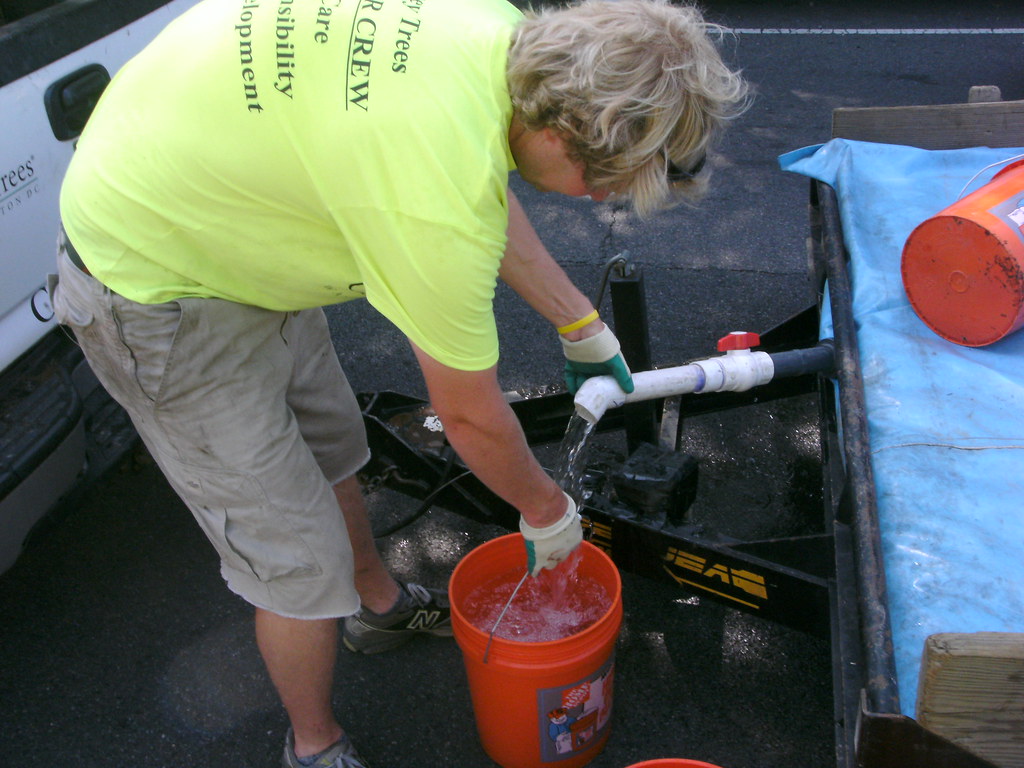 |
| Filling up a five-gallon bucket from the water bladder attached to our trailer. |
We face ample challenges throughout the week, from fighting extreme heat to the obvious safety concerns of working along busy D.C. roadways. We always make sure that safety is our main priority when we're out in the field. Occasionally, we will find ourselves tight roping a narrow median such as East Capitol or New Hampshire Avenue. However, at the end of the day we always have a sense of great satisfaction. We work hard encourage the growth of these young trees so that one day they will become giants.
Many Hands Make Healthy Trees
A big thank you to all the volunteers who came out to today's tree care event at Safe Shores! 12 volunteers from Immanuel Lutheran Church in Greenwood, South Carolina linked with Steinbruck Center and Casey Trees to help water 35 young trees. The trees were planted during a Community Tree Planting event in October. After watering and weeding this morning, volunteers toured the facility at Safe Shores and were joined by our Water By-Cycle crew. We appreciate all your help in making sure the young trees receive the necessary 25 to Stay Alive to stay hydrated in the summer heat!
Also thank you to the Living City Block DC volunteers who helped us water trees at Met Branch Trail on Saturday. 9 volunteers joined Casey Trees to water the 65 young trees and weed a section of the pathway.
 |
| A volunteer from Immanuel Lutheran Church waters a thirsty tree. |
Also thank you to the Living City Block DC volunteers who helped us water trees at Met Branch Trail on Saturday. 9 volunteers joined Casey Trees to water the 65 young trees and weed a section of the pathway.
If you or your organization are interested in participating in a tree care event, please contact Volunteer Coordinator Carol Herwig at cherwig@caseytrees.org. And don't forget - trees need 25 gallons of water per week to stay healthy. Make the pledge to water your trees and receive a free rain gauge!
Friday, July 8, 2011
Class Preview: Trees 201
Want to improve your tree identification skills, or gain a better understanding of how to select trees for planting in an urban environment?
If you'd like some help fine-tuning your understanding of trees, join us Saturday, July 16 from 9:00 AM – 12:00 PM at our Brookland Headquarters for Trees 201: Tree ID and Selection. Led by Urban Forestry Manager Sara Turner and Urban Forestry Instructor Shawn Walker, this class will provide the ins-and-outs of tree identification and selection, including both classroom and hands-on, field instruction.
While Trees 201 is geared towards Citizen Foresters and Project Organizers, all interested in building their knowledge of tree selection and identification are welcome. A light breakfast will be provided, and Continuing Education Units are offered for ISA-certified arborists. Make sure to register by Tuesday, July 12, as participants will be given a brief assignment in preparation for the class.
If you're unable to attend Trees 201, check out our calendar for more upcoming classes and events.
If you'd like some help fine-tuning your understanding of trees, join us Saturday, July 16 from 9:00 AM – 12:00 PM at our Brookland Headquarters for Trees 201: Tree ID and Selection. Led by Urban Forestry Manager Sara Turner and Urban Forestry Instructor Shawn Walker, this class will provide the ins-and-outs of tree identification and selection, including both classroom and hands-on, field instruction.
 |
| Tree walk outside the Casey Trees headquarters at a recent education event. |
While Trees 201 is geared towards Citizen Foresters and Project Organizers, all interested in building their knowledge of tree selection and identification are welcome. A light breakfast will be provided, and Continuing Education Units are offered for ISA-certified arborists. Make sure to register by Tuesday, July 12, as participants will be given a brief assignment in preparation for the class.
If you're unable to attend Trees 201, check out our calendar for more upcoming classes and events.
Friday Photo Feature - July 8, 2011
Thursday, July 7, 2011
Water By-Cycle Update
Contributing writer - Mike Ferguson, Urban Forestry Crew Chief
I have been a proud member of the Casey Trees staff for over a year and this summer I have the opportunity to be a captain for the Water By-Cycle crew. The WBC crew is composed of two bike captains and four high school students. We travel by bike to water trees in parks, like Sherman Circle, and schools such as Hyde ES and Calvin Coolidge HS. On July 5th, for example, we watered blackgum, river birch and fringe trees at Sherwood Recreation Center in Ward 6.
We face special challenges like carrying around 250 feet of hose on a bike trailer and fixing flat tires on the road. We spend our days exposed to heat and traffic so safety is of utmost concern. The bike crew takes advantage of the Metropolitan Branch Trail (where we also water trees) and bike lanes throughout the city to reach our destinations. The bike crew has set a goal to water 78 trees per day and as of July 1st we have watered 561 trees. By the end of the summer the WBC plans to water 2,574 trees.
Personally, I find great reward in watering trees that I have planted during past Community Tree Planting seasons. Last week I watered London plane trees on Monroe Street in Brookland that were among the first I planted with Casey Trees. The trees were in need of water and we pruned many suckers from the base of the trunk. I felt a sense of satisfaction after caring for trees that I had planted.
For the remainder of the program we hope to stay safe, reach our tree watering goal and enjoy the unique experience of caring for trees by bike!
I have been a proud member of the Casey Trees staff for over a year and this summer I have the opportunity to be a captain for the Water By-Cycle crew. The WBC crew is composed of two bike captains and four high school students. We travel by bike to water trees in parks, like Sherman Circle, and schools such as Hyde ES and Calvin Coolidge HS. On July 5th, for example, we watered blackgum, river birch and fringe trees at Sherwood Recreation Center in Ward 6.
We face special challenges like carrying around 250 feet of hose on a bike trailer and fixing flat tires on the road. We spend our days exposed to heat and traffic so safety is of utmost concern. The bike crew takes advantage of the Metropolitan Branch Trail (where we also water trees) and bike lanes throughout the city to reach our destinations. The bike crew has set a goal to water 78 trees per day and as of July 1st we have watered 561 trees. By the end of the summer the WBC plans to water 2,574 trees.
Personally, I find great reward in watering trees that I have planted during past Community Tree Planting seasons. Last week I watered London plane trees on Monroe Street in Brookland that were among the first I planted with Casey Trees. The trees were in need of water and we pruned many suckers from the base of the trunk. I felt a sense of satisfaction after caring for trees that I had planted.
For the remainder of the program we hope to stay safe, reach our tree watering goal and enjoy the unique experience of caring for trees by bike!
 |
| Mike Ferguson with the new Water By-Cycle trailer |
Summer Tree Spots: Tudor Place
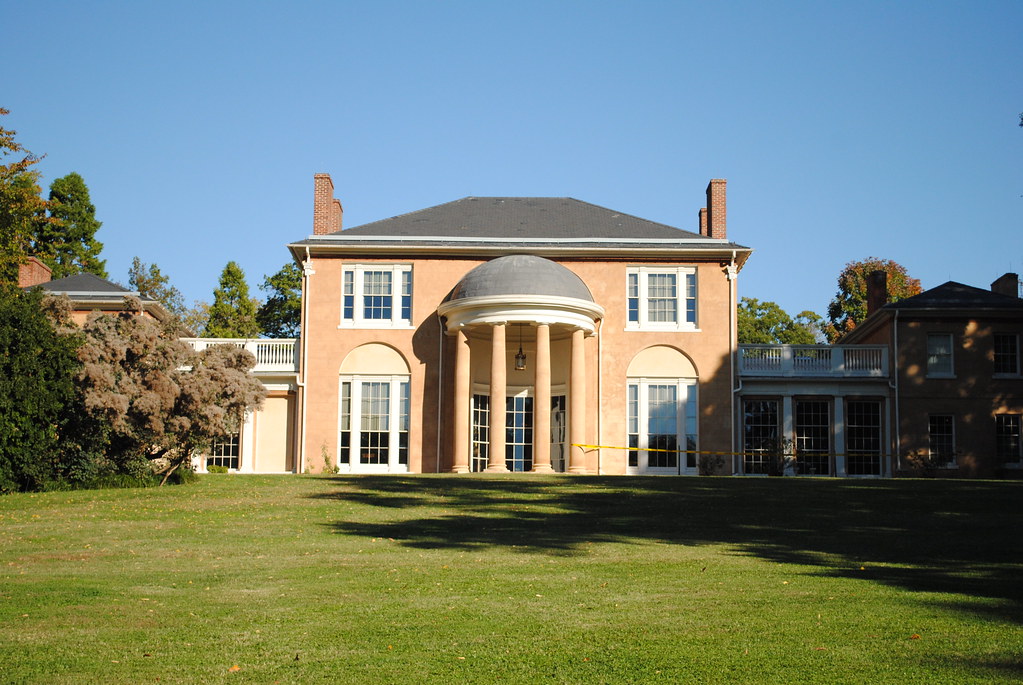 |
| The house and front lawn at Tudor Place. |
We’re all familiar with the big-time historical attractions in D.C. They’re magnificent, of course, but the monuments, the Mall and the museums can cast a large shadow over less-visited spots in the District that deserve some limelight.
Tudor Place Historic House and Garden offers the perfect pause from mainstream D.C. sightseeing. Overlooking Georgetown at 1644 31st Street Northwest, Tudor Place is home to a beautiful garden, a historical museum and - of course - various kinds of trees. About two-thirds of the property is shaded by a diverse tree canopy, which houses species such as kobus magnolia, yellow buckeye, Kentucky coffee-tree, Normann fir and more.
 |
| The massive tulip poplar tree on the southeast grounds. |
The estate used to be the home of Martha Washington’s granddaughter Martha Curtis Peter and remained in the family from 1816 until 1983. Tudor Place is now open for public viewing Tuesday through Saturday from 10 a.m. to 4 p.m. and on Sundays from noon to 4 p.m. Take time this summer to check out all that Tudor Place has to offer!
During your visit, don’t miss:
- The 100+ personal objects that belonged to George and Martha Washington, including one of the two known surviving letters from George Washington to Martha.
- A large scarlet oak tree on the north side. The oak was planted in 1932 to commemorate George Washington’s would-be 200th birthday.
- A tulip poplar that was deemed D.C.’s Millennium Tree, located on the south side of the estate.
- A large pecan tree that Casey Trees named the champion of its species in 2006.
- Our trees! Casey Trees planted 26 young trees at Tudor Place during two Community Tree Planting events, one last October and the other this past April. Visit our plantings map and zoom in on 1644 31st Street for species and locations.
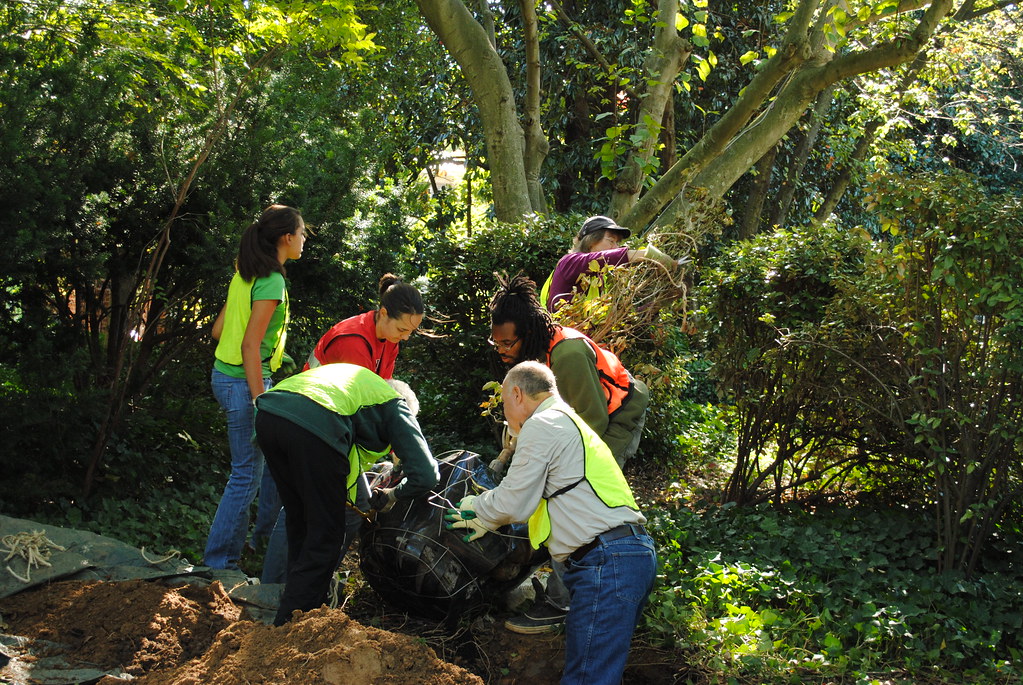 |
| Volunteers plant with Casey Trees at Tudor Place in October. See our Flickr page for more photos. |
Tudor Place is about a 25-minute walk from Dupont Circle Station on the Red Line. Buses 32, 36 and the Georgetown-Union Station Circulator also serve Wisconsin Avenue nearby. Admission for a docent-led house tour and a self-guided garden tour is $8.00 Admission for the self-guided garden tour only is $3.00.
Wednesday, July 6, 2011
Summer Crew Update #3: Professional Development
Contributing writer - Na'Quesha Taylor, Summer Crew Team Member
My two weeks at Casey Trees has been very well spent. On Thursday, we had our first professional development exercise to learn more about tree care. It was an experience I will never forget. We earn professional development outings by meeting or surpassing our weekly tree care goals. Our trip to Daingerfield Island marked us beating our goal of 1,081 "tree touches" by almost 20 trees.
On Daingerfield Island, we worked with Barry Stahl who runs the American elm nursery for the National Park Service. We started off with re-potting one-year-old elms whose roots had outgrown their small pots. I re-potted nine baby elms and I got to save one from being thrown away with the other "runts of the litter." The tag on my baby elm read "Quesha Taylor's Saved Tree." After that we pruned a few of the two-year-old trees and added stakes to guide their growth.
Afterward Barry took us outside to the nursery to transplant three-year-old elms. It was a little difficult at first but Jabbari and Mitchell helped me out. Together we transplanted three elms. This event helped the entire Summer Crew team forge a stronger bond since this Water By-Cycle and truck teams generally work separately. While we always have fun, getting to work and relax together was a huge bonus.
Following lunch Barry took us to an acre of land at the tip of the island filled with trees and giant weeds. Our job was to remove the weeds so people could see the river through the grove and make the area more safe for young students who visit to help plant the trees. When the area was clear, we planted trees. We all planted one tree that we could claim as our own. I picked a very special spot for my elm tree with just enough shade and sunlight. I cannot wait to go back in a few years to see how well the trees are doing.
We ended the day back at Barry's garage eating watermelon. Even though we were all tired, we still managed to laugh and keep smiles on our faces. I can’t wait until we reach our next goal so I can learn more about trees spend more time with the entire Summer Crew team.
My two weeks at Casey Trees has been very well spent. On Thursday, we had our first professional development exercise to learn more about tree care. It was an experience I will never forget. We earn professional development outings by meeting or surpassing our weekly tree care goals. Our trip to Daingerfield Island marked us beating our goal of 1,081 "tree touches" by almost 20 trees.
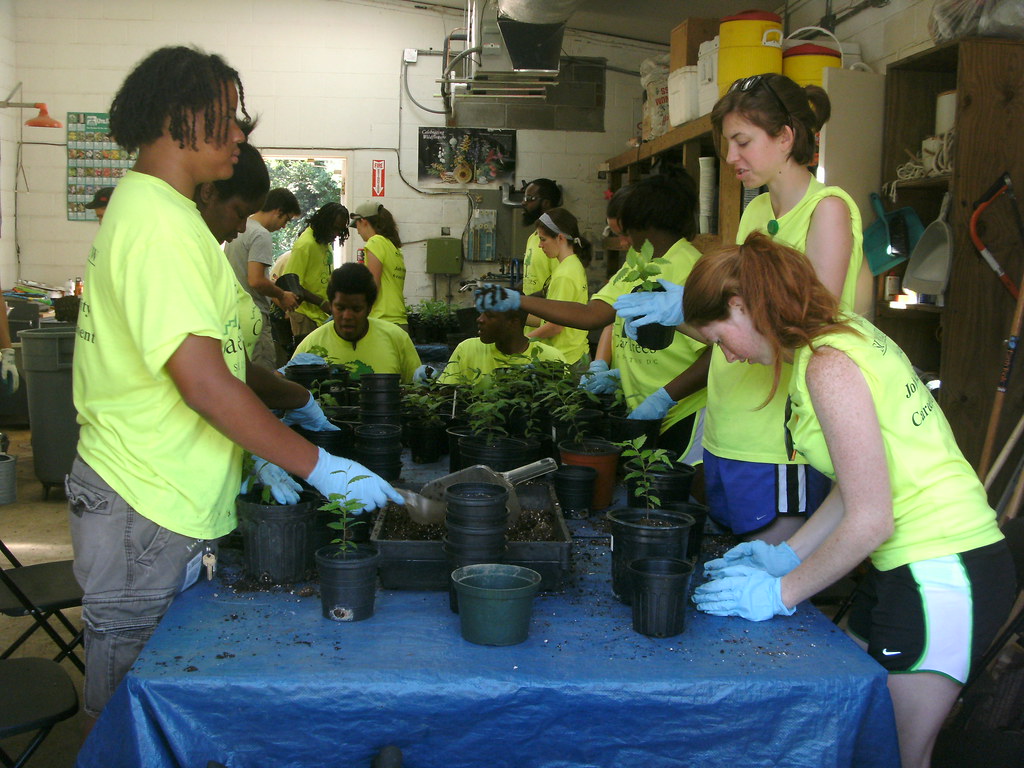 |
| Fellow Summer Crew members selecting and re-potting one-year-old elms. |
On Daingerfield Island, we worked with Barry Stahl who runs the American elm nursery for the National Park Service. We started off with re-potting one-year-old elms whose roots had outgrown their small pots. I re-potted nine baby elms and I got to save one from being thrown away with the other "runts of the litter." The tag on my baby elm read "Quesha Taylor's Saved Tree." After that we pruned a few of the two-year-old trees and added stakes to guide their growth.
Afterward Barry took us outside to the nursery to transplant three-year-old elms. It was a little difficult at first but Jabbari and Mitchell helped me out. Together we transplanted three elms. This event helped the entire Summer Crew team forge a stronger bond since this Water By-Cycle and truck teams generally work separately. While we always have fun, getting to work and relax together was a huge bonus.
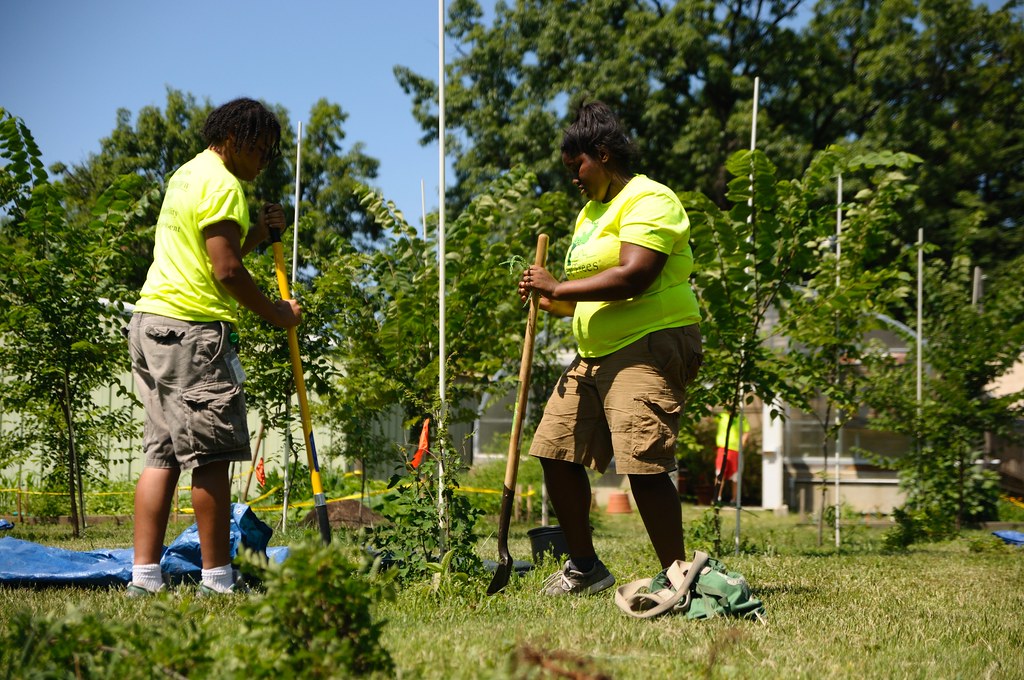 |
| Planting young American elms at the Daingerfield Island nursery. |
Following lunch Barry took us to an acre of land at the tip of the island filled with trees and giant weeds. Our job was to remove the weeds so people could see the river through the grove and make the area more safe for young students who visit to help plant the trees. When the area was clear, we planted trees. We all planted one tree that we could claim as our own. I picked a very special spot for my elm tree with just enough shade and sunlight. I cannot wait to go back in a few years to see how well the trees are doing.
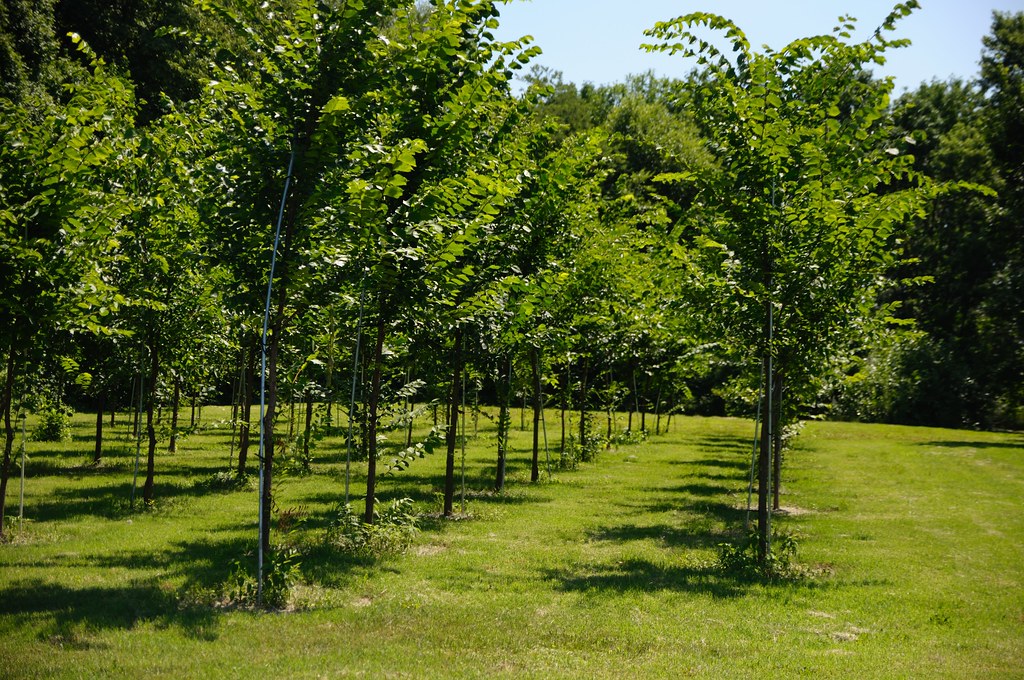 |
| Three-year-old American elms. |
We ended the day back at Barry's garage eating watermelon. Even though we were all tired, we still managed to laugh and keep smiles on our faces. I can’t wait until we reach our next goal so I can learn more about trees spend more time with the entire Summer Crew team.
Subscribe to:
Posts (Atom)


